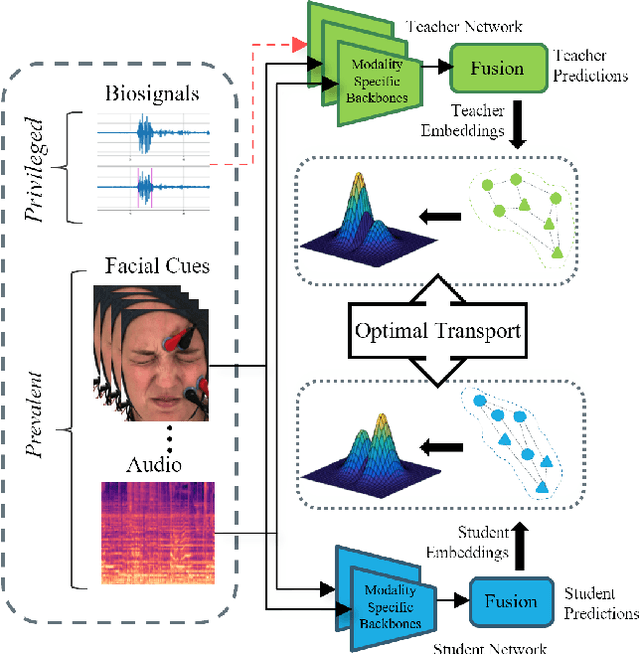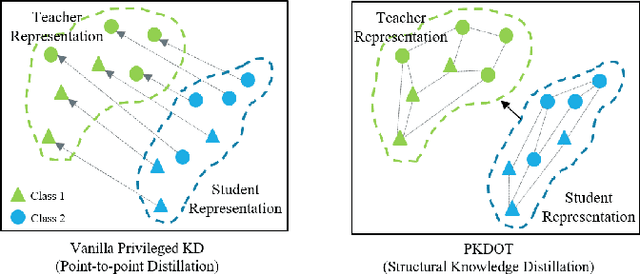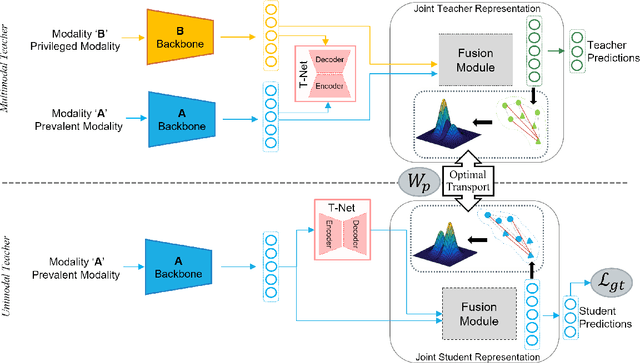Soufiane Belharbi
BAH Dataset for Ambivalence/Hesitancy Recognition in Videos for Behavioural Change
May 25, 2025



Abstract:Recognizing complex emotions linked to ambivalence and hesitancy (A/H) can play a critical role in the personalization and effectiveness of digital behaviour change interventions. These subtle and conflicting emotions are manifested by a discord between multiple modalities, such as facial and vocal expressions, and body language. Although experts can be trained to identify A/H, integrating them into digital interventions is costly and less effective. Automatic learning systems provide a cost-effective alternative that can adapt to individual users, and operate seamlessly within real-time, and resource-limited environments. However, there are currently no datasets available for the design of ML models to recognize A/H. This paper introduces a first Behavioural Ambivalence/Hesitancy (BAH) dataset collected for subject-based multimodal recognition of A/H in videos. It contains videos from 224 participants captured across 9 provinces in Canada, with different age, and ethnicity. Through our web platform, we recruited participants to answer 7 questions, some of which were designed to elicit A/H while recording themselves via webcam with microphone. BAH amounts to 1,118 videos for a total duration of 8.26 hours with 1.5 hours of A/H. Our behavioural team annotated timestamp segments to indicate where A/H occurs, and provide frame- and video-level annotations with the A/H cues. Video transcripts and their timestamps are also included, along with cropped and aligned faces in each frame, and a variety of participants meta-data. We include results baselines for BAH at frame- and video-level recognition in multi-modal setups, in addition to zero-shot prediction, and for personalization using unsupervised domain adaptation. The limited performance of baseline models highlights the challenges of recognizing A/H in real-world videos. The data, code, and pretrained weights are available.
PixelCAM: Pixel Class Activation Mapping for Histology Image Classification and ROI Localization
Mar 31, 2025Abstract:Weakly supervised object localization (WSOL) methods allow training models to classify images and localize ROIs. WSOL only requires low-cost image-class annotations yet provides a visually interpretable classifier, which is important in histology image analysis. Standard WSOL methods rely on class activation mapping (CAM) methods to produce spatial localization maps according to a single- or two-step strategy. While both strategies have made significant progress, they still face several limitations with histology images. Single-step methods can easily result in under- or over-activation due to the limited visual ROI saliency in histology images and the limited localization cues. They also face the well-known issue of asynchronous convergence between classification and localization tasks. The two-step approach is sub-optimal because it is tied to a frozen classifier, limiting the capacity for localization. Moreover, these methods also struggle when applied to out-of-distribution (OOD) datasets. In this paper, a multi-task approach for WSOL is introduced for simultaneous training of both tasks to address the asynchronous convergence problem. In particular, localization is performed in the pixel-feature space of an image encoder that is shared with classification. This allows learning discriminant features and accurate delineation of foreground/background regions to support ROI localization and image classification. We propose PixelCAM, a cost-effective foreground/background pixel-wise classifier in the pixel-feature space that allows for spatial object localization. PixelCAM is trained using pixel pseudo-labels collected from a pretrained WSOL model. Both image and pixel-wise classifiers are trained simultaneously using standard gradient descent. In addition, our pixel classifier can easily be integrated into CNN- and transformer-based architectures without any modifications.
Disentangled Source-Free Personalization for Facial Expression Recognition with Neutral Target Data
Mar 26, 2025



Abstract:Facial Expression Recognition (FER) from videos is a crucial task in various application areas, such as human-computer interaction and health monitoring (e.g., pain, depression, fatigue, and stress). Beyond the challenges of recognizing subtle emotional or health states, the effectiveness of deep FER models is often hindered by the considerable variability of expressions among subjects. Source-free domain adaptation (SFDA) methods are employed to adapt a pre-trained source model using only unlabeled target domain data, thereby avoiding data privacy and storage issues. Typically, SFDA methods adapt to a target domain dataset corresponding to an entire population and assume it includes data from all recognition classes. However, collecting such comprehensive target data can be difficult or even impossible for FER in healthcare applications. In many real-world scenarios, it may be feasible to collect a short neutral control video (displaying only neutral expressions) for target subjects before deployment. These videos can be used to adapt a model to better handle the variability of expressions among subjects. This paper introduces the Disentangled Source-Free Domain Adaptation (DSFDA) method to address the SFDA challenge posed by missing target expression data. DSFDA leverages data from a neutral target control video for end-to-end generation and adaptation of target data with missing non-neutral data. Our method learns to disentangle features related to expressions and identity while generating the missing non-neutral target data, thereby enhancing model accuracy. Additionally, our self-supervision strategy improves model adaptation by reconstructing target images that maintain the same identity and source expression.
Text- and Feature-based Models for Compound Multimodal Emotion Recognition in the Wild
Jul 17, 2024Abstract:Systems for multimodal Emotion Recognition (ER) commonly rely on features extracted from different modalities (e.g., visual, audio, and textual) to predict the seven basic emotions. However, compound emotions often occur in real-world scenarios and are more difficult to predict. Compound multimodal ER becomes more challenging in videos due to the added uncertainty of diverse modalities. In addition, standard features-based models may not fully capture the complex and subtle cues needed to understand compound emotions. %%%% Since relevant cues can be extracted in the form of text, we advocate for textualizing all modalities, such as visual and audio, to harness the capacity of large language models (LLMs). These models may understand the complex interaction between modalities and the subtleties of complex emotions. Although training an LLM requires large-scale datasets, a recent surge of pre-trained LLMs, such as BERT and LLaMA, can be easily fine-tuned for downstream tasks like compound ER. This paper compares two multimodal modeling approaches for compound ER in videos -- standard feature-based vs. text-based. Experiments were conducted on the challenging C-EXPR-DB dataset for compound ER, and contrasted with results on the MELD dataset for basic ER. Our code is available
SR-CACO-2: A Dataset for Confocal Fluorescence Microscopy Image Super-Resolution
Jun 13, 2024



Abstract:Confocal fluorescence microscopy is one of the most accessible and widely used imaging techniques for the study of biological processes. Scanning confocal microscopy allows the capture of high-quality images from 3D samples, yet suffers from well-known limitations such as photobleaching and phototoxicity of specimens caused by intense light exposure, which limits its use in some applications, especially for living cells. Cellular damage can be alleviated by changing imaging parameters to reduce light exposure, often at the expense of image quality. Machine/deep learning methods for single-image super-resolution (SISR) can be applied to restore image quality by upscaling lower-resolution (LR) images to produce high-resolution images (HR). These SISR methods have been successfully applied to photo-realistic images due partly to the abundance of publicly available data. In contrast, the lack of publicly available data partly limits their application and success in scanning confocal microscopy. In this paper, we introduce a large scanning confocal microscopy dataset named SR-CACO-2 that is comprised of low- and high-resolution image pairs marked for three different fluorescent markers. It allows the evaluation of performance of SISR methods on three different upscaling levels (X2, X4, X8). SR-CACO-2 contains the human epithelial cell line Caco-2 (ATCC HTB-37), and it is composed of 22 tiles that have been translated in the form of 9,937 image patches for experiments with SISR methods. Given the new SR-CACO-2 dataset, we also provide benchmarking results for 15 state-of-the-art methods that are representative of the main SISR families. Results show that these methods have limited success in producing high-resolution textures, indicating that SR-CACO-2 represents a challenging problem. Our dataset, code and pretrained weights are available: https://github.com/sbelharbi/sr-caco-2.
Source-Free Domain Adaptation of Weakly-Supervised Object Localization Models for Histology
Apr 29, 2024Abstract:Given the emergence of deep learning, digital pathology has gained popularity for cancer diagnosis based on histology images. Deep weakly supervised object localization (WSOL) models can be trained to classify histology images according to cancer grade and identify regions of interest (ROIs) for interpretation, using inexpensive global image-class annotations. A WSOL model initially trained on some labeled source image data can be adapted using unlabeled target data in cases of significant domain shifts caused by variations in staining, scanners, and cancer type. In this paper, we focus on source-free (unsupervised) domain adaptation (SFDA), a challenging problem where a pre-trained source model is adapted to a new target domain without using any source domain data for privacy and efficiency reasons. SFDA of WSOL models raises several challenges in histology, most notably because they are not intended to adapt for both classification and localization tasks. In this paper, 4 state-of-the-art SFDA methods, each one representative of a main SFDA family, are compared for WSOL in terms of classification and localization accuracy. They are the SFDA-Distribution Estimation, Source HypOthesis Transfer, Cross-Domain Contrastive Learning, and Adaptively Domain Statistics Alignment. Experimental results on the challenging Glas (smaller, breast cancer) and Camelyon16 (larger, colon cancer) histology datasets indicate that these SFDA methods typically perform poorly for localization after adaptation when optimized for classification.
Realistic Model Selection for Weakly Supervised Object Localization
Apr 15, 2024Abstract:Weakly Supervised Object Localization (WSOL) allows for training deep learning models for classification and localization, using only global class-level labels. The lack of bounding box (bbox) supervision during training represents a considerable challenge for hyper-parameter search and model selection. Earlier WSOL works implicitly observed localization performance over a test set which leads to biased performance evaluation. More recently, a better WSOL protocol has been proposed, where a validation set with bbox annotations is held out for model selection. Although it does not rely on the test set, this protocol is unrealistic since bboxes are not available in real-world applications, and when available, it is better to use them directly to fit model weights. Our initial empirical analysis shows that the localization performance of a model declines significantly when using only image-class labels for model selection (compared to using bounding-box annotations). This suggests that adding bounding-box labels is preferable for selecting the best model for localization. In this paper, we introduce a new WSOL validation protocol that provides a localization signal without the need for manual bbox annotations. In particular, we leverage noisy pseudo boxes from an off-the-shelf ROI proposal generator such as Selective-Search, CLIP, and RPN pretrained models for model selection. Our experimental results with several WSOL methods on ILSVRC and CUB-200-2011 datasets show that our noisy boxes allow selecting models with performance close to those selected using ground truth boxes, and better than models selected using only image-class labels.
Joint Multimodal Transformer for Dimensional Emotional Recognition in the Wild
Mar 15, 2024Abstract:Audiovisual emotion recognition (ER) in videos has immense potential over unimodal performance. It effectively leverages the inter- and intra-modal dependencies between visual and auditory modalities. This work proposes a novel audio-visual emotion recognition system utilizing a joint multimodal transformer architecture with key-based cross-attention. This framework aims to exploit the complementary nature of audio and visual cues (facial expressions and vocal patterns) in videos, leading to superior performance compared to solely relying on a single modality. The proposed model leverages separate backbones for capturing intra-modal temporal dependencies within each modality (audio and visual). Subsequently, a joint multimodal transformer architecture integrates the individual modality embeddings, enabling the model to effectively capture inter-modal (between audio and visual) and intra-modal (within each modality) relationships. Extensive evaluations on the challenging Affwild2 dataset demonstrate that the proposed model significantly outperforms baseline and state-of-the-art methods in ER tasks.
Guided Interpretable Facial Expression Recognition via Spatial Action Unit Cues
Feb 02, 2024Abstract:While state-of-the-art facial expression recognition (FER) classifiers achieve a high level of accuracy, they lack interpretability, an important aspect for end-users. To recognize basic facial expressions, experts resort to a codebook associating a set of spatial action units to a facial expression. In this paper, we follow the same expert footsteps, and propose a learning strategy that allows us to explicitly incorporate spatial action units (aus) cues into the classifier's training to build a deep interpretable model. In particular, using this aus codebook, input image expression label, and facial landmarks, a single action units heatmap is built to indicate the most discriminative regions of interest in the image w.r.t the facial expression. We leverage this valuable spatial cue to train a deep interpretable classifier for FER. This is achieved by constraining the spatial layer features of a classifier to be correlated with \aus map. Using a composite loss, the classifier is trained to correctly classify an image while yielding interpretable visual layer-wise attention correlated with aus maps, simulating the experts' decision process. This is achieved using only the image class expression as supervision and without any extra manual annotations. Moreover, our method is generic. It can be applied to any CNN- or transformer-based deep classifier without the need for architectural change or adding significant training time. Our extensive evaluation on two public benchmarks RAFDB, and AFFECTNET datasets shows that our proposed strategy can improve layer-wise interpretability without degrading classification performance. In addition, we explore a common type of interpretable classifiers that rely on Class-Activation Mapping methods (CAMs), and we show that our training technique improves the CAM interpretability.
Distilling Privileged Multimodal Information for Expression Recognition using Optimal Transport
Jan 27, 2024



Abstract:Multimodal affect recognition models have reached remarkable performance in the lab environment due to their ability to model complementary and redundant semantic information. However, these models struggle in the wild, mainly because of the unavailability or quality of modalities used for training. In practice, only a subset of the training-time modalities may be available at test time. Learning with privileged information (PI) enables deep learning models (DL) to exploit data from additional modalities only available during training. State-of-the-art knowledge distillation (KD) methods have been proposed to distill multiple teacher models (each trained on a modality) to a common student model. These privileged KD methods typically utilize point-to-point matching and have no explicit mechanism to capture the structural information in the teacher representation space formed by introducing the privileged modality. We argue that encoding this same structure in the student space may lead to enhanced student performance. This paper introduces a new structural KD mechanism based on optimal transport (OT), where entropy-regularized OT distills the structural dark knowledge. Privileged KD with OT (PKDOT) method captures the local structures in the multimodal teacher representation by calculating a cosine similarity matrix and selects the top-k anchors to allow for sparse OT solutions, resulting in a more stable distillation process. Experiments were performed on two different problems: pain estimation on the Biovid dataset (ordinal classification) and arousal-valance prediction on the Affwild2 dataset (regression). Results show that the proposed method can outperform state-of-the-art privileged KD methods on these problems. The diversity of different modalities and fusion architectures indicates that the proposed PKDOT method is modality and model-agnostic.
 Add to Chrome
Add to Chrome Add to Firefox
Add to Firefox Add to Edge
Add to Edge